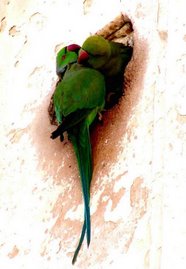

The seasonal flu kills about 36,000 people every year and sends 200,000 to the hospital, according to the U.S. Centers for Disease Control and Prevention. But most of those cases involve people who are elderly, very young or weakened by another condition.
For most sufferers -- between 5 and 20 percent of the population every year -- the flu brings fever, headaches, fatigue, aches and pains, stomach distress and other symptoms that make life miserable for days.
A pandemic flu outbreak would be an entirely different problem.
The flu virus mutates frequently and sometimes a new strain emerges that humans have not been exposed to. If the strain spreads easily between humans, it can cause widespread death and overwhelm global health resources.
"Unlike seasonal flu, most people have not built up resistance to it. And unlike seasonal flu, it can kill those who are young and healthy, as well as those who are frail and sick," President Bush said in a November 1 speech announcing a $7.1 billion plan to prepare for a possible pandemic. "At this moment, there is no pandemic influenza in the United States or the world. But if history is our guide, there's reason to be concerned."
Three influenza pandemics swept the globe in the 20th century. The worst, in 1918-19, killed 20 million to 50 million people, according to the CDC, and triggered an international panic. (Witness to 1918 flu)
Health officials stress that there is no evidence of a pandemic flu outbreak anywhere in the world, but say that the avian flu that has spread across Asia and Europe is a cause for concern.
The H5N1 strain of the avian flu has infected 126 people and killed 64 since 2003, according to the World Health Organization. It does not spread easily between humans -- most of the cases have been contracted by handling infected poultry.
The fear is that the H5N1 will mutate, or that it will combine with another strain of influenza and become more contagious, according to the U.S. Department of Health and Human Services plan for responding to a possible pandemic.
HHS Secretary Mike Leavitt told CNN that there was no way to know if the bird flu would become a pandemic, but said it was only a matter of time before a strain of flu virus did.
He said that such an outbreak would be a natural disaster of unique proportions.
"It can happen in 5,000 different communities around the world at the same time. No central place can manage all of those difficulties and so local communities need to be ready, and part of the president's plan is to assure that they are," Leavitt said.
Flu season unpredictable
So far this season, flu activity has been relatively low, according to the Centers for Disease Control and Prevention. Experts say it's too early to tell how bad the season will be.
"Until we begin to see epidemic spread in some parts of the country, we're not really going to be able to say a whole lot about the season, except that it's not going to be extremely early," said Arnold S. Monto, a professor of epidemiology at the University of Michigan.
He said that a typical flu season starts around Thanksgiving and peaks around Christmas, though it can be earlier or later.
"The only thing we can predict with certainty about flu is that it's unpredictable," said CDC Director Julie Gerberding. "We just can't tell at the beginning of the season, like we are now, how bad it's going to be and when it's going to peak."
Gerberding said that immunization is the biggest thing that people can do to protect themselves from the disease, combined with simple hygiene.
"It's ...very important to keep your hands clean, to wash your hands frequently so that you're not picking it up inadvertently, and try not to touch your eyes or your mouth," she said. "I know that's hard, but it's kind of good old-fashioned respiratory hygiene."
Monto said that some parts of the country have not yet gotten the vaccine, but said that there should be enough doses for everyone who wants them.
"You don't have to get it in November, if there's no flu around you, you can continue to get it in December or even into January, and by that time there should be plenty of vaccine available," he said.
Pandemic plan
A key element of the president's flu plan is the allocation of $2.8 billion to fund a "crash program" to accelerate the development of vaccines. (Is the United States prepared?)
The current system relies on a process developed in the 1950s to grow the vaccine in billions of chicken eggs.
Scientists must wait until a new strain emerges to create a vaccine, so a faster system would have the potential to save many lives.
The plan calls for spending $1 billion to stockpile anti-viral drugs -- such as Tamiflu and Relenza -- to protect first-responders and $583 million for "pandemic preparedness." That would include $100 million for states to make plans.
It also calls for $251 million to help other countries train medical personnel and improve their capacity to detect and contain outbreaks.



1 коментар:
I didn't know about it that much until I read this article, maybe I read about it before but I forgot.
Публикуване на коментар